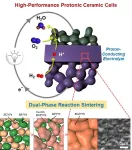(Press-News.org) In many countries in Africa, up to nine out of ten children suffer from a skin problem, and there are far too few local dermatologists. Artificial intelligence could help with diagnosis, but needs to be trained with the relevant images, so researchers have created a new data set for dark skin tones.
Demand is high, the lack of dermatologists acute: in many countries in Africa, there is less than one dermatology specialist per one million people – compared to the World Health Organization (WHO) recommendation of one specialist per 50,000. This lack of specialists is noticeable in rural Africa in particular, with up to 87% of children suffering from untreated skin diseases.
The PASSION project (abbreviation for Pediatric AI Skin Support In Outreach Nations) has been set up with the aim of remedying this problem: a team of researchers from the University of Basel, led by Professor Alexander Navarini, worked with colleagues from Madagascar, Malawi and Guinea to create a foundation for using artificial intelligence (AI) to support dermatological diagnostics in these regions. They are presenting the project at the MICCAI 2024 conference (International Conference on Medical Image Computing and Computer Assisted Intervention) in Marrakesh.
Lack of images of dark skin tones
If AI is to detect eczema from a photo, for example, it first needs to learn what eczema looks like based on hundreds of photos. But the existing photos are primarily of skin problems in light skin types, which have been provided as documentation by clinics in Europe and the USA. The medical shortage in a lot of countries in Africa also means that there is a lack of image material for skin problems in pigmented skin. If AI programs are only trained using photos of light skin, they may be much less effective at diagnosing changes on darker skin tones.
The researchers have therefore created a database of images of very common skin diseases: eczema, fungal infections of the skin and nails, scabies and superficial skin infections with streptococci or staphylococci. This data set can be used to train new AI programs for dermatological diagnostics, but also to test existing AI models for accuracy.
The images were taken, with the patients’ consent, by local dermatologists in Madagascar, Malawi and Guinea from 2020 to 2023. The images were annotated to include the diagnosis and information on the age, gender and body part, and then entered into the anonymized database. The database now contains over 4,200 images of skin changes in around 1300 patients, two thirds of whom are under 18.
Self-diagnosis using a smartphone
“Our vision is that each patient will be able to take a photo of their skin problem themselves free of charge using a smartphone and then upload it. They will then receive a treatment recommendation from AI,” says Navarini. If this method is as accurate as it is hoped, it will be possible to use it in triage and, where appropriate, for initial treatment. Human dermatologists would only be involved if the complaint persists.
“We are currently testing the method step by step as part of a validation study in Madagascar. Once diagnostic accuracy exceeds 80%, we intend to offer the new diagnostic tool with scientific monitoring,” explains Philippe Gottfrois, doctoral student in Navarini’s research group and lead author of the study.
In the next steps, the researchers aim to expand the database to include additional image material, primarily of neglected tropical skin diseases. They hope that AI will be able to narrow the large gap in dermatological care in these regions.
END
AI-supported dermatology: Now for darker skin tones too, thanks to a new data set
2024-10-10
ELSE PRESS RELEASES FROM THIS DATE:
Understanding how smiling influences relationship building during real-life conversations
2024-10-10
Smiling during conversations creates warmth, making people feel more comfortable and connected. For example, a friendly smile when meeting someone new can ease nervousness. A smile can soften tension in a debate, showing respect among the participants despite disagreement. In fact, extensive studies have been conducted in the past in an attempt to understand smiling interactions in a natural conversation. Despite these studies, however, little is known about the extent to which one’s smile influences or gets affected by the other person’s smile during a conversation.
A new study sought to investigate this by quantifying ...
British Heart Foundation Data Science Centre launches first open challenge to explore AI ECG potential
2024-10-10
The British Heart Foundation (BHF) Data Science Centre, led by Health Data Research UK, is hosting an open challenge which invites competitors to explore the potential of Artificial Intelligence to improve the use of electrocardiogram (ECG) for cardiovascular disease patient care. The challenge has been co-designed with members of public and patients affected by cardiovascular disease.
The BHF Data Science Centre is collaborating with experts from the University of Edinburgh to use a synthetic imaging dataset made up of approximately 20,000 simulated electrocardiogram (ECG) images. Competitors will be invited to develop algorithms which can make ...
Heart failure, atrial fibrillation & coronary heart disease linked to cognitive impairment
2024-10-10
Statement Highlights:
Previous studies have found that 14-81% of patients with heart failure experience some degree of cognitive impairment affecting language, memory or executive function.
Evidence also indicates that people with atrial fibrillation have a 39% increased risk of memory or thinking problems; adults with heart disease have a 27% higher risk of developing dementia; and up to 50% of individuals experience cognitive decline after a heart attack.
Managing heart health from an early age is important, not only for preventing heart disease but also for protecting brain health and reducing the risk of cognitive impairment in later life.
Embargoed until 4:00 a.m. CT/5:00 ...
To make children better fact-checkers, expose them to more misinformation — with oversight
2024-10-10
In an era when online misinformation is seemingly everywhere and objective facts are often in dispute, UC Berkeley psychologists in a new study have presented a somewhat paradoxical partial solution: Expose young children to more misinformation online — not less.
Doing so in limited circumstances, and with careful oversight and education, can help children gain the tools they'll need to sort fact from fiction online, said Evan Orticio, a Ph.D. student in UC Berkeley’s Department of Psychology and lead author of a paper published today ...
Renowned psychiatrist professor Celso Arango advocates for primary prevention in mental health
2024-10-10
In a revealing Genomic Press Interview published in Brain Medicine on October 10, 2024, Professor Celso Arango, a prominent psychiatrist and researcher, outlines his vision for the future of mental health care. Professor Arango, who serves as Director of the Institute of Psychiatry and Mental Health at Hospital General Universitario Gregorio Marañón and Professor of Psychiatry at the Universidad Complutense de Madrid, advocates for a paradigm shift towards primary prevention in psychiatry.
Professor Arango's career trajectory, from his early exposure to ...
Ketamine pioneer Dr. Carlos A. Zarate Jr. reshapes depression treatment landscape
2024-10-10
Bethesda, Maryland - 10 October 2024. In a revealing Genomic Press Interview published on 10 October 2024, Dr. Carlos A. Zarate Jr., NIH Distinguished Investigator and pioneer in rapid-acting antidepressant research, offers a glimpse into the personal motivations and scientific breakthroughs that have defined his career. The interview, part of the journal's Innovators and Ideas series, showcases Dr. Zarate's journey from a young tennis instructor in Argentina to a leading figure in psychiatric research at the National Institute ...
Glowing approach could aid carpal tunnel-related surgery
2024-10-10
In modern office life, avoiding the onset of carpal tunnel syndrome might be a daily struggle. The worst case could mean needing surgery to alleviate compression of the nerves or to repair damaged nerves. Helping surgeons visually check the areas where neural blood flow has decreased due to chronic nerve compression can lead to improvements in diagnostic accuracy, severity assessments, and outcome predictions.
With this in mind, an Osaka Metropolitan University-led research team involving Graduate School of Medicine student Kosuke Saito and Associate Professor Mitsuhiro Okada investigated the use of fluorescein angiography, a method employed in neurosurgery and ophthalmology ...
The hidden costs of free apps – more than personal data
2024-10-10
Procrastination, sleep deprivation and reduced focus are part of the price we pay for free mobile apps. This is according to researchers at Linköping University and RISE, who have investigated the costs hidden behind the free apps. Based on their results, they also have some advice for decision-makers.
Most of us are becoming aware that our digital attention is hard currency for companies like Google and Facebook. By analysing our digital behaviour patterns, they can target tailored advertising directly to our feeds. Our attention becomes the product that is sold to advertisers. For example, YouTube’s three billion monthly users generated ...
Hot dragonfly summer: species with darker wings have evolved to withstand heat and attract partners
2024-10-10
Temperature determines where species can live and if they are threatened by a warming climate. So, for a long time, biologists studied how heat tolerance affects survival. Yet, less is known about how thermal traits influence reproduction, which is directly linked to extinction risk.
Now, researchers in the US have examined if males of dragonfly species that produce sexual signals in the form of dark coloration on their wings are more resistant to heat. They published their results in Frontiers in Ethology.
“We show that dragonfly species that have evolved dark breeding coloration on ...
Development of a new electrolyte synthesis method for next-generation fuel cells: a step closer to green hydrogen production
2024-10-10
Dr. Ho-Il Ji from the Hydrogen Energy Materials Research Center at the Korea Institute of Science and Technology (KIST, President Sang-Rok Oh), along with Professor Sihyuk Choi's team from Kumoh National Institute of Technology, announced that they have developed a new synthesis method that can significantly reduce the sintering temperature required for the densification process of the electrolyte in next-generation high-efficiency protonic ceramic cells.
Existing solid oxide cells (SOC) can produce electricity in fuel cell operation and hydrogen in ...






